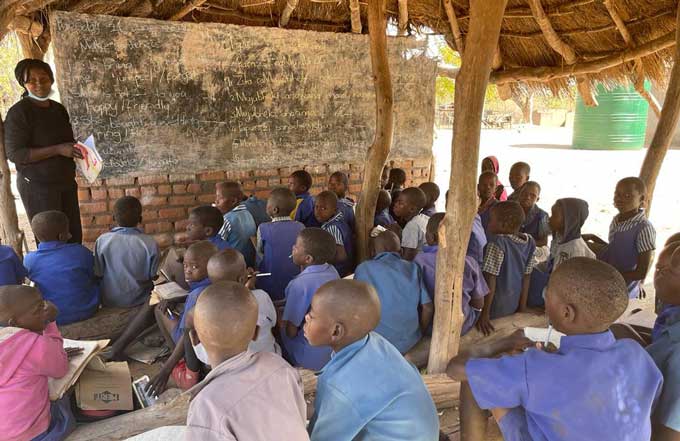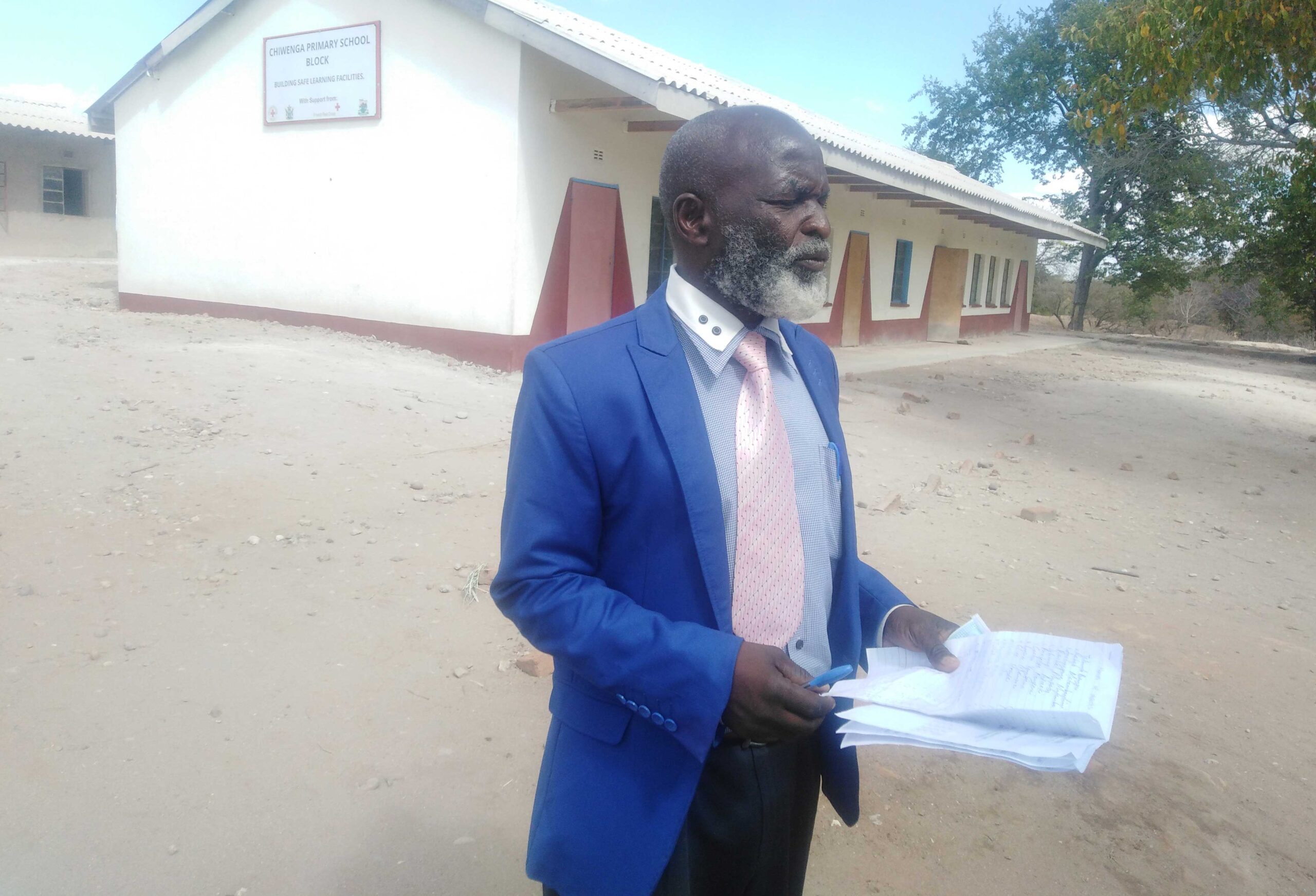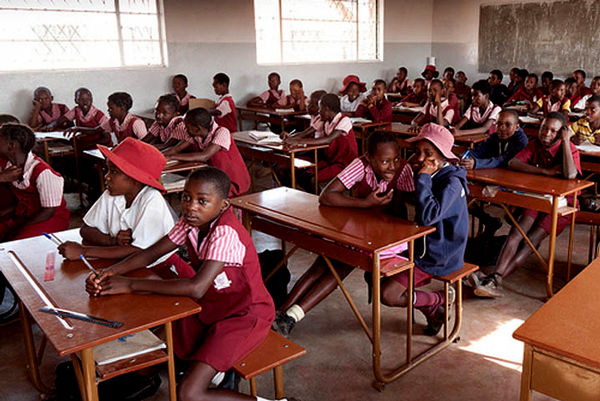
BY MOSES MUGUGUNYEKI It’s 11:45am and a Grade 1 class learning in the open at Chiwenga Primary School is wrapping up the proceedings of the day by handing over their exercise books to the teacher for marking and safe keeping.
While learners in privileged environments would take up such an opportunity to clean the classrooms and lock up books in cupboards, pupils in this class would only pick up papers, bid farewell to their teacher and walk away after dismissal.
To them and hordes of other learners in Muzarabani North, a proper classroom with charts stuck on the walls and learning materials hanging or stored in a corner remains but a dream.
The teacher said there were 55 pupils registered in her class, but on this day, only 29 had braved the cold morning breeze to attend lessons.

Just a few metres from the Grade 1 class, there is a Grade 3 class that is conducting lessons under a thatched structure.
Only a handful of pupils have come to school on the day out of the 50 registered by the school.
Both teachers blamed the windy conditions on the day for the poor turnout.
The situation at Chiwenga Primary School and many other schools in the district exposes learners to harsh teaching and learning environments compelling them to drop out of school.
- Chamisa under fire over US$120K donation
- Mavhunga puts DeMbare into Chibuku quarterfinals
- Pension funds bet on Cabora Bassa oilfields
- Councils defy govt fire tender directive
Keep Reading
According to Unesco, worldwide 258 million children and youth are still out of school for social, economic and cultural reasons.
While Zimbabwe is part of global and regional political drives to ensure that all children have access and complete education, little has been done to achieve this goal in hard-to-reach communities such as Muzarabani district.
Part of the district is found in the Zambezi basin and here resides one of the most marginalised communities in the country.
The country is working towards the Sustainable Development Goal of providing universal and free education to all students by 2030, but this looks unattainable in Muzarabani.
“Most of our children have failed to get quality education here in Chiwenga because of the poor state of our schools,” said a villager, Israel Mutombo.
“The school has over the years failed to retain qualified teachers because of poor infrastructure, among other challenges.”
However, Mutombo said there have been some changes in the past five years, thanks to the Zimbabwe Red Cross Society (ZRCS), through its Muzarabani Resilience Project, that has transformed the Chiwenga community.
“We saw the Red Cross install a solar-powered water system here in Chiwenga and we now have tapped water at the school, clinic, shopping centre and villages,” Mutombo said.
“The water project has done wonders for the school because in the past teachers would shun deployment and sought transfers citing lack of water.
“Teachers would fetch water from Mukumbura River where they would be competing with animals and those that would be using the water for other activities.”
He said poor sanitation and hygiene resulted in the school experiencing diarrhoea outbreaks.
According to a recent WHO/Unicef Joint Monitoring Programme (JMP) for Wash 2021 report, globally, 29% of schools do not have a basic drinking water service, impacting 546 million schoolchildren; 28% do not have basic sanitation services, impacting 539 million children and 42% do not have basic hygiene services, impacting 802 million children.
Mutombo said apart from the water project, the ZRCS built a standard classroom block at the school, which will house the Grade 7 class that all along had been writing their final examinations at Chadereka, 40km away.
“Grade 7 pupils used to write exams in Chadereka, some 40km away and this affected both the learners and the teachers,” he said.
“It was a cumbersome task, but they had no choice because the school did not meet the standard of an examination centre.”
Chiwenga Primary School head Francis Chirunga confirmed that they were struggling to provide quality education due to the sorry-state of the school.

“It’s always difficult to provide quality education in such circumstances,” Chirunga said.
“Teachers used to shun this school because of lack of water and other amenities.
“However, we have seen some improvements lately with the coming in of the Red Cross who availed water and built a classroom block at the school.”
Chirunga was optimistic that the Grade 7 class would for the first time write final examinations at the school.
“You don’t expect good results when you travel to another school to write examinations, but I am hopeful this year our pupils will write their examination here,” he said.
“The Local Government ministry and Physical Planning officials were here and assessed the new classroom block.
“We have 65 pupils who will write their examinations this year and I am optimistic that this time we will have good results.”
Chiwenga villagers said a new satellite secondary school was opened in the area early this year to serve secondary school learners, who previously travelled long distances to other places.
“There were no secondary school in this area and the secondary school over that side was only established this year,” said a villager.
“There are no structures at the secondary school save for a teachers’ cottage.
“Some of the learners come from faraway places and this is not conducive enough for their learning.”
At Kairezi in ward 23, primary and secondary school learners share the same structures.
“We are still housed at the primary school where we share the few classroom blocks available,” said Kairezi Secondary School head Jonah Makaza.
“Such an environment is not favourable for proper learning.
“The shortage of proper classroom blocks is the biggest challenge and water used to be a problem, but we now have tapped water from the Red Cross.”
Councillor for Kairezi, Amon Mavedzenge said they were mobilising resources to construct the secondary school.
“We know the situation is not good for proper learning, so we are working with the government and development partners to put structures at the secondary school,” Mavedzenge said.

“The community now has water after the Red Cross installed a solar-powered borehole in Kabaira village which is serving the school, clinic, shopping centre and community.”
Mavedzenge said the water system would transform the area, particularly the schools that failed to attract qualified teachers.
“Our teachers this time will stay put as we have tapped water in the schools,” he said.
“They will embark on projects to sustain the school and they can also enhance the learning of practical subjects like Agriculture.”
The councillor confirmed that there was a shortage of schools in the ward.
“We need more primary schools and to complete construction of the secondary school if we are to provide quality education in this area,” he said.
ZRCS secretary-general Elias Hwenga said the Muzarabani Resilience Project, which is being supported by the Finnish Red Cross, seeks to address issues around disasters, food security as well as Wash (water, sanitation and hygiene).
“We have been championing programmes in Muzarabani, ranging from water and sanitation, to food security and livelihoods initiatives, construction of footbridges as well as community resilience through integrated health and disaster risk reduction programming,” Hwenga said.
“The Chiwenga Water Scheme and the Kabaira Water Scheme try to address the WASH challenges that these communities have been facing over the years.
“Gone are the days of piecemeal solutions to community challenges.
“Communities must be empowered through long-term developmental projects that are well-thought out and bring lasting solutions to everyday challenges.”
Hwenga said construction of the Chiwenga Primary School classroom block came after the realisation that the school had one classroom block and makeshift classrooms that exposed pupils to natural hazards.
“The disaster risk reduction programme was meant to address the lack of standard and safe learning structures for school children at Chiwenga Primary School,” said Hwenga.
“Children learn in makeshift structures that do not have floors or furniture while outside they sit on dusty ground, exposing both teachers and learners to respiratory infections.
“At worst the structures can easily collapse if a storm hits the school, causing injuries or deaths.
“During the rainy season students are dismissed early as there is not enough space for them.
“As a result of these substandard learning facilities, the school was not registered as an examination centre for Grade 7 exams.”
Hwenga said the project was in line with ZRCS’ comprehensive school safe model, which it is championing to mitigate disasters in schools.
Muzarabani North MP Zhemu Soda last year told The Standard that efforts were being done to address the challenges faced by the education sector in the district in line with the National Development Strategy 1.
Soda said he was spearheading the construction of a school block at Chiwenga Secondary School on top of other infrastructural development projects being implemented across the district.
Last year Muzarabani Rural District Council constructed classrooms blocks at Batanai and Gumbochuma primary schools using devolution funds.











